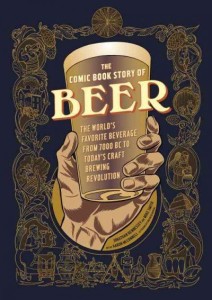 Growing up I was terribly serious. I was 50 when I was 16. I read Hobbes and Marco Polo and Boccaccio and Cervantes for fun. That said, my favorite book, the one that I returned to more often than not, was an odd graphic novel that I’ve never seen in print again. It was called Rock Toons and it was basically a comic book format retelling of the first 30 years of Rock and Roll. As a result I may have been the only teenager in Leaside in the 90’s with an opinion about Alan Freed and payola.
Growing up I was terribly serious. I was 50 when I was 16. I read Hobbes and Marco Polo and Boccaccio and Cervantes for fun. That said, my favorite book, the one that I returned to more often than not, was an odd graphic novel that I’ve never seen in print again. It was called Rock Toons and it was basically a comic book format retelling of the first 30 years of Rock and Roll. As a result I may have been the only teenager in Leaside in the 90’s with an opinion about Alan Freed and payola.
The Comic Book Story of Beer: The World’s Favorite Beverage From 7000 BC To Today’s Craft Brewing Revolution reminds me a lot of that book.
The format has a lot to recommend it. A straight telling of the history of beer is going to take hundreds of pages to convey information and is likely to be pretty digressive. When you consider that Pete Brown’s Hops and Glory basically covers IPA and is itself a few hundred pages long, you can see the difficulty in packing in an eon.
The Comic Book Story of Beer manages to seamlessly convey all the information you need about the history of beer in a graphic novel format. The stylistic choices in design and art contribute a level of detail that’s more or less unbeatable.
One of the difficulties that you get in beer history is that beer does not exist in a vacuum. If you’re going to tell the story, it has to be within the context of the society in which it exists. It’s great to know, for instance, that X brewery was at Y location in Z year and produced B barrels, but without the larger societal context you may as well be trainspotting.
Take for instance the section on Gruit. It contains an incredible amount of densely packed contextual information. Any other book would struggle to contain the following information in way that made you care: Gruit contained certain herbs and the mixture was distributed in a cartel style format which was eventually supplanted by hops.
In this section you get an idea of what the ingredients look like, the brewing equipment people used, the clothes they wore, the architecture of the period, the costume of church officials, the fire of Hamburg etc, etc. You get that in about three pages with greater understanding than you might in a different format.
The other real advantage is that the book is able to take advantage of religious iconography that we’re largely familiar with when dealing with pre-history and the emergence of civilization. Replication of photography is used to great effect in the section on prohibition. The diversity of artistic styles is helpful and lightly whimsical. I particularly like the use of lego style figures in explaining the building blocks of beer production.
As a result, the advantage of The Comic Book Story of Beer is that it is able to meet you halfway. The imagery is accessible and interesting and the history is well researched and presented. As with any history there are bits experts might quibble with, but there are no howlers. As such, it meets its presumed mission statement exceedingly well: Giving newbies a firm general grounding in beer in an accessible way. Just about any beer drinker would get a kick out of it, though.